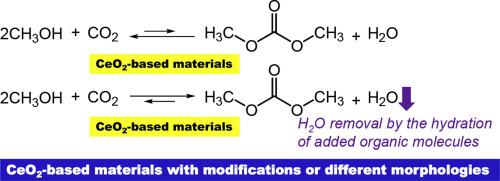Materials Today Sustainability ( IF 7.1 ) Pub Date : 2020-03-19 , DOI: 10.1016/j.mtsust.2020.100035 K. Tomishige , Y. Gu , T. Chang , M. Tamura , Y. Nakagawa

|
CeO2 shows unique catalytic properties by an acid–base bifunctionality as well as redox properties. The acid–base bifunctional properties of CeO2 have been applied to the non-reductive CO2 conversion with alcohols such as dimethyl carbonate (DMC) synthesis from CO2 and methanol. CeO2 shows very high selectivity to DMC; however, the yield of DMC is strongly limited by the equilibrium. The combination of the synthesis of organic carbonates from CO2 and corresponding alcohols with suitable H2O removal methods can enhance the yield of the organic carbonates beyond the equilibrium limitation. Many CeO2-based materials have been prepared and tested in the reaction of CO2 with alcohols. As is known, what catalysts can do is to make the reactions progress to the equilibrium level in reversible reactions and the catalysts do not influence the equilibrium level and thermodynamics of the reactions. In order to evaluate the catalytic properties of CeO2-based materials in this reaction, we should pay more attention to the catalytic activity. In addition, the catalytic activity should be measured under the reaction conditions at a sufficiently lower conversion level than that at the equilibrium level, because the effect of the reverse reaction can be neglected. The catalytic performance of the CeO2-based materials is compared considering the equilibrium level under the reaction conditions. Morphology, oxide ion defects (or oxygen vacancies), as well as acid–base properties on the catalytic performance can influence the catalytic activity; however, it seems to be difficult to elucidate crucial factors. Therefore, development of CeO2-based materials with much higher catalytic activities than reported results is necessary, which will contribute to the determination of the most crucial factor.
中文翻译:

CeO 2在CO 2与醇的非还原转化中的催化作用
CeO 2通过酸碱双功能以及氧化还原特性显示出独特的催化性能。CeO 2的酸碱双功能特性已应用于通过醇(例如由CO 2和甲醇合成的碳酸二甲酯(DMC))进行的非还原性CO 2转化。CeO 2对DMC具有很高的选择性。但是,DMC的收率受到平衡的强烈限制。由CO 2和相应的醇合成有机碳酸酯与合适的H 2 O去除方法相结合,可以提高有机碳酸酯的收率超过平衡极限。许多CeO 2基材料已经制备并在CO 2与醇的反应中进行了测试。众所周知,催化剂可以做的是使反应在可逆反应中发展到平衡水平,并且催化剂不影响反应的平衡水平和热力学。为了评估基于CeO 2的材料在该反应中的催化性能,我们应更加注意其催化活性。另外,因为可以忽略逆反应的作用,所以在反应条件下以比平衡水平足够低的转化率来测量催化活性。CeO 2的催化性能考虑到反应条件下的平衡水平,比较了基料。形态,氧化物离子缺陷(或氧空位)以及催化性能的酸碱性质都可能影响催化活性。但是,似乎很难阐明关键因素。因此,有必要开发出比报道的结果具有更高催化活性的基于CeO 2的材料,这将有助于确定最关键的因素。











































 京公网安备 11010802027423号
京公网安备 11010802027423号